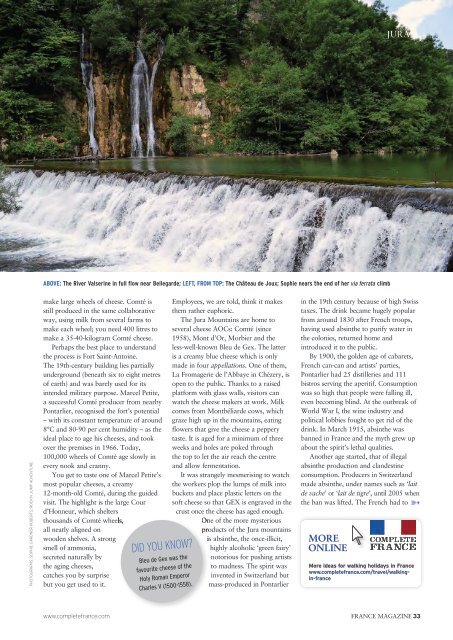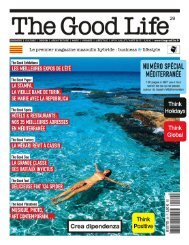Create successful ePaper yourself
Turn your PDF publications into a flip-book with our unique Google optimized e-Paper software.
JURA<br />
ABOVE: The River Valserine in full flow near Bellegarde; LEFT, FROM TOP: The Château de Joux; Sophie nears the end of her via ferrata climb<br />
PHOTOGRAPHS: SOPHIE GARDNER-ROBERTS; ROCK’N JUMP ADVENTURE<br />
make large wheels of cheese. Comté is<br />
still produced in the same collaborative<br />
way, using milk from several farms to<br />
make each wheel; you need 400 litres to<br />
make a 35-40-kilogram Comté cheese.<br />
Perhaps the best place to understand<br />
the process is Fort Saint-Antoine.<br />
The 19th-century building lies partially<br />
underground (beneath six to eight metres<br />
of earth) and was barely used for its<br />
intended military purpose. Marcel Petite,<br />
a successful Comté producer from nearby<br />
Pontarlier, recognised the fort’s potential<br />
– with its constant temperature of around<br />
8°C and 80-90 per cent humidity – as the<br />
ideal place to age his cheeses, and took<br />
over the premises in 1966. Today,<br />
100,000 wheels of Comté age slowly in<br />
every nook and cranny.<br />
You get to taste one of Marcel Petite’s<br />
most popular cheeses, a creamy<br />
12-month-old Comté, during the guided<br />
visit. The highlight is the large Cour<br />
d’Honneur, which shelters<br />
thousands of Comté wheels,<br />
all neatly aligned on<br />
wooden shelves. A strong<br />
smell of ammonia,<br />
secreted naturally by<br />
the aging cheeses,<br />
catches you by surprise<br />
but you get used to it.<br />
DID YOU KNOW?<br />
Bleu de Gex was the<br />
favourite cheese of the<br />
Holy Roman Emperor<br />
Charles V (1500-1558).<br />
Employees, we are told, think it makes<br />
them rather euphoric.<br />
The Jura Mountains are home to<br />
several cheese AOCs: Comté (since<br />
1958), Mont d’Or, Morbier and the<br />
less-well-known Bleu de Gex. The latter<br />
is a creamy blue cheese which is only<br />
made in four appellations. One of them,<br />
La Fromagerie de l’Abbaye in Chézery, is<br />
open to the public. Thanks to a raised<br />
platform with glass walls, visitors can<br />
watch the cheese makers at work. Milk<br />
comes from Montbéliarde cows, which<br />
graze high up in the mountains, eating<br />
flowers that give the cheese a peppery<br />
taste. It is aged for a minimum of three<br />
weeks and holes are poked through<br />
the top to let the air reach the centre<br />
and allow fermentation.<br />
It was strangely mesmerising to watch<br />
the workers plop the lumps of milk into<br />
buckets and place plastic letters on the<br />
soft cheese so that GEX is engraved in the<br />
crust once the cheese has aged enough.<br />
One of the more mysterious<br />
products of the Jura mountains<br />
is absinthe, the once-illicit,<br />
highly alcoholic ‘green fairy’<br />
notorious for pushing artists<br />
to madness. The spirit was<br />
invented in Switzerland but<br />
mass-produced in Pontarlier<br />
in the 19th century because of high Swiss<br />
taxes. The drink became hugely popular<br />
from around 1830 after French troops,<br />
having used absinthe to purify water in<br />
the colonies, returned home and<br />
introduced it to the public.<br />
By 1900, the golden age of cabarets,<br />
French can-can and artists’ parties,<br />
Pontarlier had 25 distilleries and 111<br />
bistros serving the aperitif. Consumption<br />
was so high that people were falling ill,<br />
even becoming blind. At the outbreak of<br />
World War I, the wine industry and<br />
political lobbies fought to get rid of the<br />
drink. In March 1915, absinthe was<br />
banned in <strong>France</strong> and the myth grew up<br />
about the spirit’s lethal qualities.<br />
Another age started, that of illegal<br />
absinthe production and clandestine<br />
consumption. Producers in Switzerland<br />
made absinthe, under names such as ‘lait<br />
de vache’ or ‘lait de tigre’, until 2005 when<br />
the ban was lifted. The French had to<br />
MORE<br />
ONLINE<br />
More ideas for walking holidays in <strong>France</strong><br />
www.completefrance.com/travel/walkingin-france<br />
➳<br />
www.completefrance.com FRANCE MAGAZINE 33






